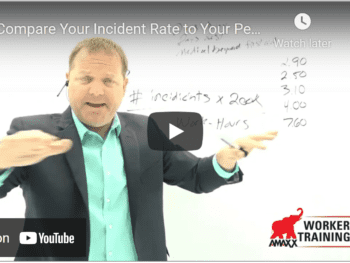One of the keys to achieving a profitable business is protecting the business from unnecessary operating costs. An easy way to eliminate unnecessary expense is through the risk management technique of a loss prevention program. A loss prevention program reduces the cost of workers' compensation insurance and eliminates much of the unseen cost of workers’ comp injuries.
In addition to the medical benefits and indemnity benefits paid to injured employees, there are substantial other unseen cost incurred by the employer, not the workers’ comp insurer, related to any workers’ comp claim including:
1. The time loss from work activities by the injured employee, other employees, and supervisors.
2. The time spent hiring and training new employees to replace the injured employee.
3. The drop in product or service quality by the new hires in comparison to the quality produced by the experienced employee.
4. The time spent completing paperwork on the injury, the time spent processing or forwarding medical bills to the insurer and the time spent on record keeping
5. The time spent working with the adjuster, the medical provider, the nurse case manager, and the employee in getting the employee back to work.
6. The time spent attending hearings and/or conferences.
7. The loss of goodwill with customers and/or the loss of customers.
A loss prevention program assists your company in mitigating the cost of both the workers’ compensation insurance and the unseen cost associated with every injury. The framework of your loss prevention program should include at a minimum:
- A corporate policy
- Safety training
- Work site inspections
Corporate Policy
Your company needs an established loss prevention program; one that includes a published safety policy. Make all employees aware of the safety policy and the requirement their active participation in the safety program is expected. A good way to accomplish employee participation is to provide the safety policy as a part of the new hire orientation, one requiring new employees to read and sign a copy of the safety policy.
Safety goals must be realistic and clearly stated. Establish a system of measuring performance against the goals publish the results where they can be clearly seen by all employees. One example of a measurable goal used by many companies is: “the number of days without a lost time injury.”
Safety Training
Training employees to act and work in a safe manner, is one of the best ways to prevent accidents from happening. When the employees know ahead of time certain actions may result in their being injured, they will act in a safe way to protect themselves. By teaching the employees to recognize hazards you build loss prevention into their every day work activities.
Teach your employees to recognize these risks or hazards avoid:
1. The bypassing or making inoperative safety devices or machinery guards.
2. The improper use of tools and equipment.
3. The using of equipment the employee has not been trained to use.
4. The failure to use protective gear and protective clothing.
5. The improper storing of supplies or materials.
6. The failure to use proper lifting techniques.
7. The use of defective tools or equipment.
8. The use of equipment with inadequate lighting.
9. The failure to keep floors clean and dry.
10. The improper use of electrical wiring or outlets.
When a new hire or an experienced employee starts a work assignment where they many lack experience, the supervisor needs to carefully explain not only the task to be done, but also the hazards associated with the task and how to prevent an injury from occurring. Once the employee starts the task or new assignment, the supervisor needs to observe and have the employee explain each step of the work process and repeat back to the supervisor what the hazards are and how to avoid them.
The safety training needs to include scheduled loss prevention talks by the supervisor or manager. These can be informal talks covering the risk associated with a change in productions methods, the cause of a recent accident, or why a particular hazard is of concern. The supervisor or manager solicits feedback from the employees at the loss prevention talks to ensure their understanding and compliance with the safety program.
Work Site Inspections
In addition to a corporate program and safety training, it is essential for your company has a work site inspection program. Based on your own work accident history, look for the conditions causing injuries in the past. By recognizing the causes of past injuries, you can take steps now to prevent the same type of injuries from occurring in the future.
Create an inspection checklist to use you in recognizing and eliminating hazards such as poor housekeeping, congested areas, unsafe acts, and unsafe conditions. Based on the results of your inspection, you can take action to correct deficiencies noted and to prevent the deficiencies from occurring again. (workersxzcompxzkit)
Summary
A properly created loss prevention program significantly reduces the cost of workers' compensation and reduces other unseen costs to the employer. If you need assistance with your loss prevention program, please contact us. We have extensive training materials and guides designed to assist you in creating a loss prevention program or improving your current loss prevention program.
Author Rebecca Shafer, Consultant/Attorney, President, Amaxx Risks Solutions, Inc. has worked successfully for 20 years with many industries to reduce Workers’ Compensation costs, including airlines, healthcare, manufacturing, printing/publishing, pharmaceuticals, retail, hospitality and manufacturing. Contact: [email protected] or 860-553-6604.
FREE WC IQ Test: http://www.workerscompkit.com/intro/
WC Books: http://www.reduceyourworkerscomp.com/workers-comp-books-manuals.php
WC Calculator: http://www.reduceyourworkerscomp.com/calculator.php
TD Calculator: http://www.reduceyourworkerscomp.com/transitional-duty-cost-calculator.php
Do not use this information without independent verification. All state laws vary. You should consult with your insurance broker or agent about workers' comp issues.
©2010 Amaxx Risk Solutions, Inc. All rights reserved under International Copyright Law. If you would like permission to reprint this material, contact [email protected]















